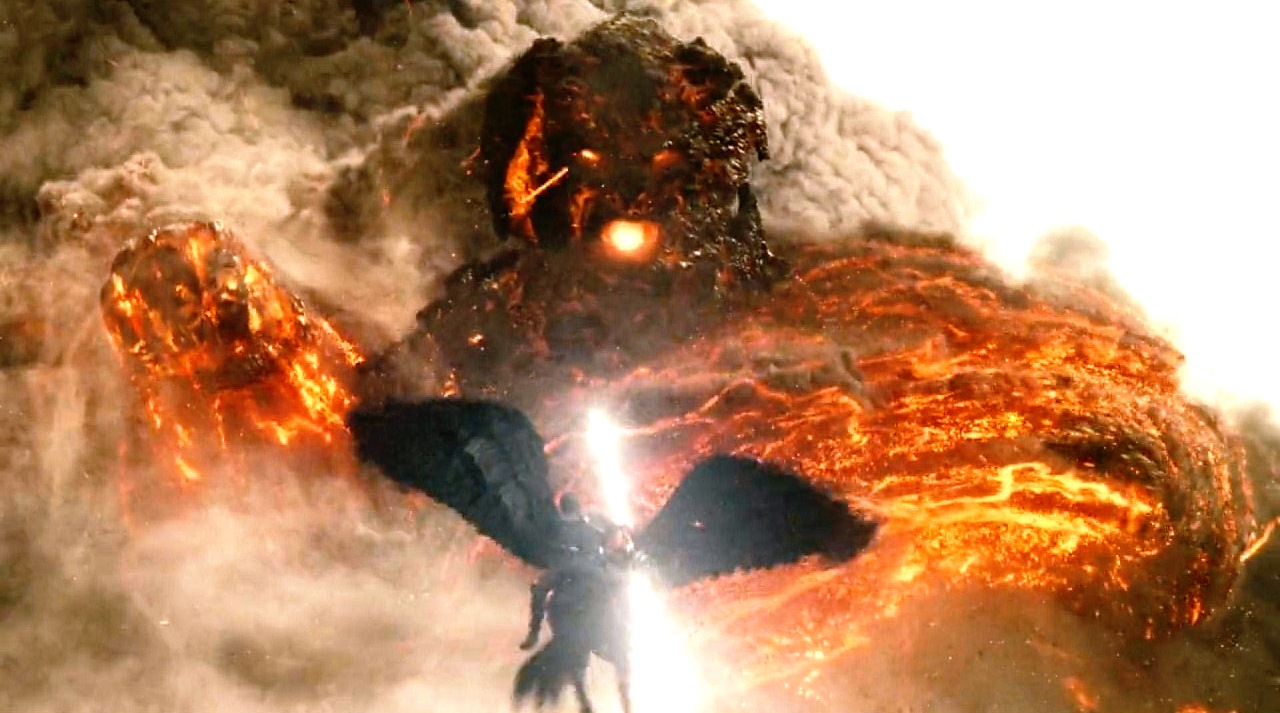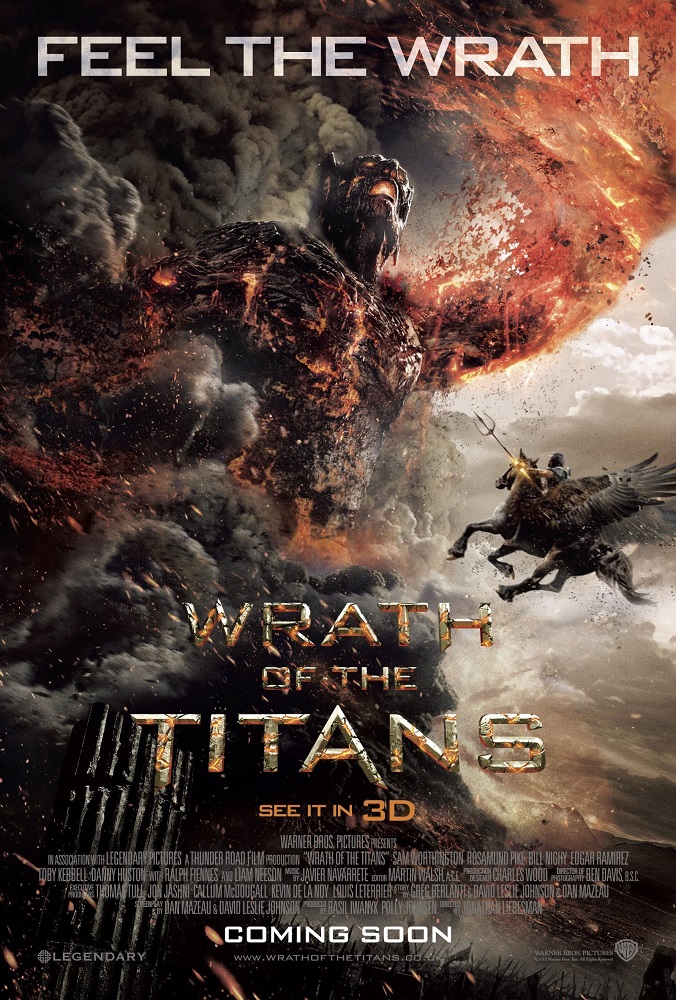Crew
Director – Jonathan Liebesman, Screenplay – David Leslie Johnson & Dan Mazeau, Story – Greg Berlanti, David Leslie Johnson & Dan Mazeau, Producers – Basil Iwanyk & Polly Johnsen, Photography – Ben Davis, Music – Javier Navarette, Visual Effects Supervisor – Nick Davis, Additional Visual Effects Supervisor – Chris Shaw, Visual Effects – Framestore (Supervisor – Jonathan Fawkner), Method (Supervisor – Olivier Dumont), MPS (Supervisor – Gary Drozenick), Nvizible, Pixomondo & The Senate, Special Effects Supervisor – Neil Corbould, Animatronics Supervisor – Darren Robinson, Production Design – Charles Wood. Production Company – Thunder Road/Colt Productions/Furia de Titanes II.
Cast
Sam Worthington (Perseus), Liam Neeson (Zeus), Ralph Fiennes (Hades), Rosamund Pike (Andromeda), Toby Kebbell (Agenor), Edgar Ramirez (Ares), Bill Nighy (Hephaestus), John Bell (Helius), Danny Huston (Poseidon), Sinead Cusack (Clea), Alejandro Naranjo (Mantius), Lily James (Korinna)
Plot
Perseus has settled down to a simple life as a fisherman while raising his son Helius. He receives a visit from his father Zeus who warns him that bad things are about to happen. Zeus, Poseidon and Ares are summoned to a meeting with Hades only for Hades and Ares to turn on the others, killing Poseidon and imprisoning Zeus, announcing that they are going to drain his powers in order to free Zeus and Hades’s father, the Titan Kronos. Persues flees an attack on his village by creatures of the underworld. He goes to seek the aid of Andromeda, who has become queen, and frees Poseidon’s half-mortal son Agenor from imprisonment to guide them. Perseus then sets out to find the means to fight back against Ares and stop the unleashed Kronos, which requires venturing into the Labyrinth and gathering the weapons created by Hephaestus.
Wrath of the Titans is a sequel to Clash of the Titans (2010). This in turn was a remake of the earlier stop-motion animated Ray Harryhausen film Clash of the Titans (1981). Clash of the Titans 2010 received a good deal of negative critical reception, being slammed for turning the original into an empty-headed CGI fest. Most of all, what people hated was the fact that Clash of the Titans was one of the first films seeking to jump aboard the renewed 3D fad following the success of Avatar (2009) where it was a film originally shot in 2D that had been quickly and poorly repackaged in post-production to be sold to audiences as a 3D film. Wrath of the Titans is a post-converted 3D film too but the sophistication of the process is such that the conversion now looks a good deal smoother and more effective.
Sam Worthington, Liam Neeson and Ralph Fiennes return in the respective roles they played first time around, while the part of Andromeda is again present but with Alexa Davalos having been recast with Rosamund Pike. Wrath of the Titans has been placed in the hands of Jonathan Liebesman, a director who began with B-budget horror fare like Darkness Falls (2003), before gravitating to The Texas Chainsaw Massacre: The Beginning (2006) and most recently the moderate hit of the alien invasion spectacle Battle Los Angeles (2011) and subsequently the reboot of Teenage Mutant Ninja Turtles (2014).
Clash of the Titans 2010 was a reasonable success. One suspects the reason for this was somewhere between the presence of star Sam Worthington and 3D being a then new novelty, causing audiences to flock to it expecting more Avatar – and maybe to a lesser extent it riding the 00s interest in fantasy cinema. The dictum that appears to have been given to Jonathan Liesbesman and the scriptwriters is to simply produce more of the same but with bigger monsters and more explosions. You sense that the Wrath of the Titans producers’ fail to understand that the first film’s success was a freak confluence of interests and one predicts that Wrath is not going to be as big a hit as Clash.
Clash of the Titans had Perseus setting out on a quest to save Andromeda from sacrifice by the gods; Wrath of the Titans ups the scale and has the gods defeated and Perseus having to set out on a quest to find the magic items needed to defeat the gods-who-are-even-more-powerful-than-the-gods, The Titans. The plot follows essentially the same path as the first film – despite having found his destiny as a demi-god, Perseus has returned to the life of the simple fisherman, exactly the same place he was at the start of Clash. He must once again gather a team of people and set forth on what John Clute calls a ‘Plot Coupons’ quest, a fantasy plot in which a party must collect certain magical items for a specified purpose and undergo various encounters in the process of doing so. A big monster is unleashed at the climax and Perseus must again make a daring flight aboard the Pegasus to do the one thing that can stop it. Oh and there is another throwaway in-joke appearance from Bubo the mechanical owl from the 1981 film.

The minor difference might be that there seems to be more of an element of humour present in Wrath of the Titans than there was in Clash with some of the Brits among the cast, a wryly cocky Toby Kebbell and an amusingly doddery Bill Nighy, managing to effortlessly steal the show from the largely nondescript others.
As with Clash of the Titans 2010 and indeed Clash of the Titans 1981 and most of Ray Harryhausen’s films before that, Wrath of the Titans feels like it is written in a direct line that is designed to connect up effects set-pieces with a minimum of complexity. The film tosses these up with timed regularity – Cerberus rampaging through and torching Perseus’s village; the encounters with several giant-sized Cyclops; the venture into the Labyrinth; the creatures of the underworld massacring the army; the climactic emergence of the vast lava-spewing Kronos.
There is the tendency of the script to pillage pieces from other Greek myths – the Cyclops from The Odyssey, and in particular the story of the Labyrinth and encounter with the Minotaur from the legend of Theseus, which at least gets a more authentic airing here than it did in the recent Immortals (2011), even though there is still no King Minos. (You can hardly be too strict on Wrath of the Titans for its mix and match approach to Greek mythology as the original 1981 film did this to such an extent that it even borrowed the Kraken from Norse mythology).
The special effects are epic and expert – far more so than they were in Clash of the Titans 2010. It makes for a pretty show of flash, bang and wow, even if the spectacle eventually washes over you with all of the sum and substance of a disco ball light.
(Nominee for Best Special Effects at this site’s Best of 2012 Awards).


